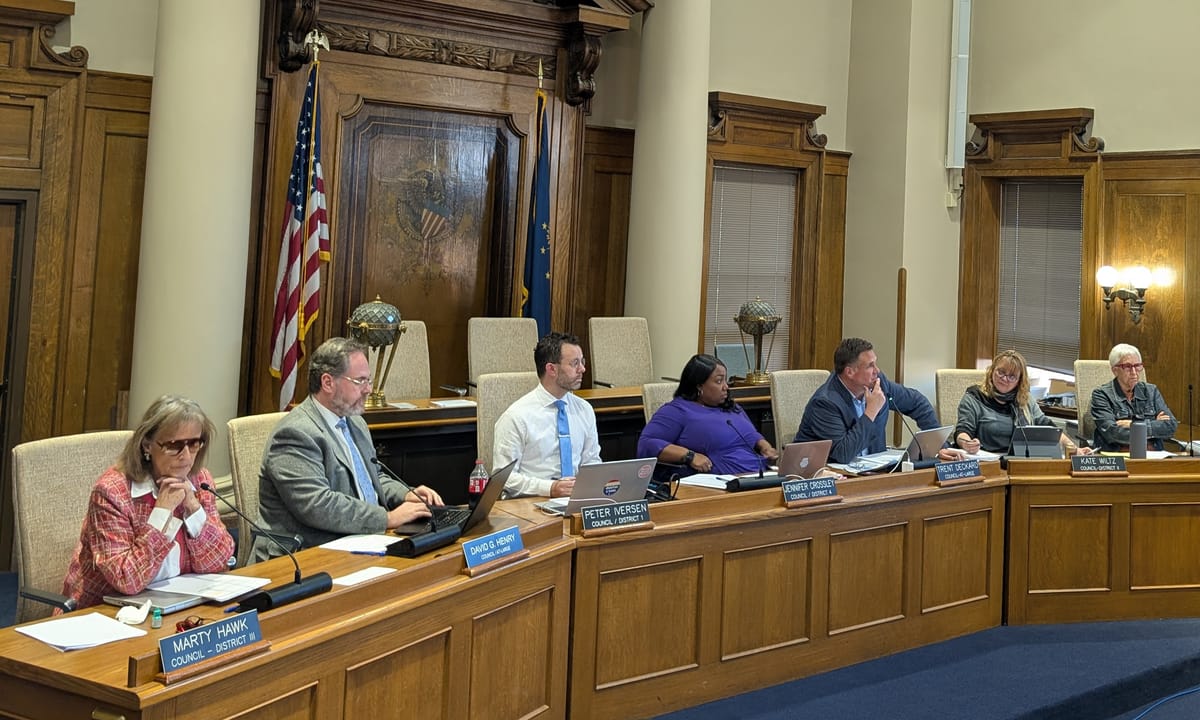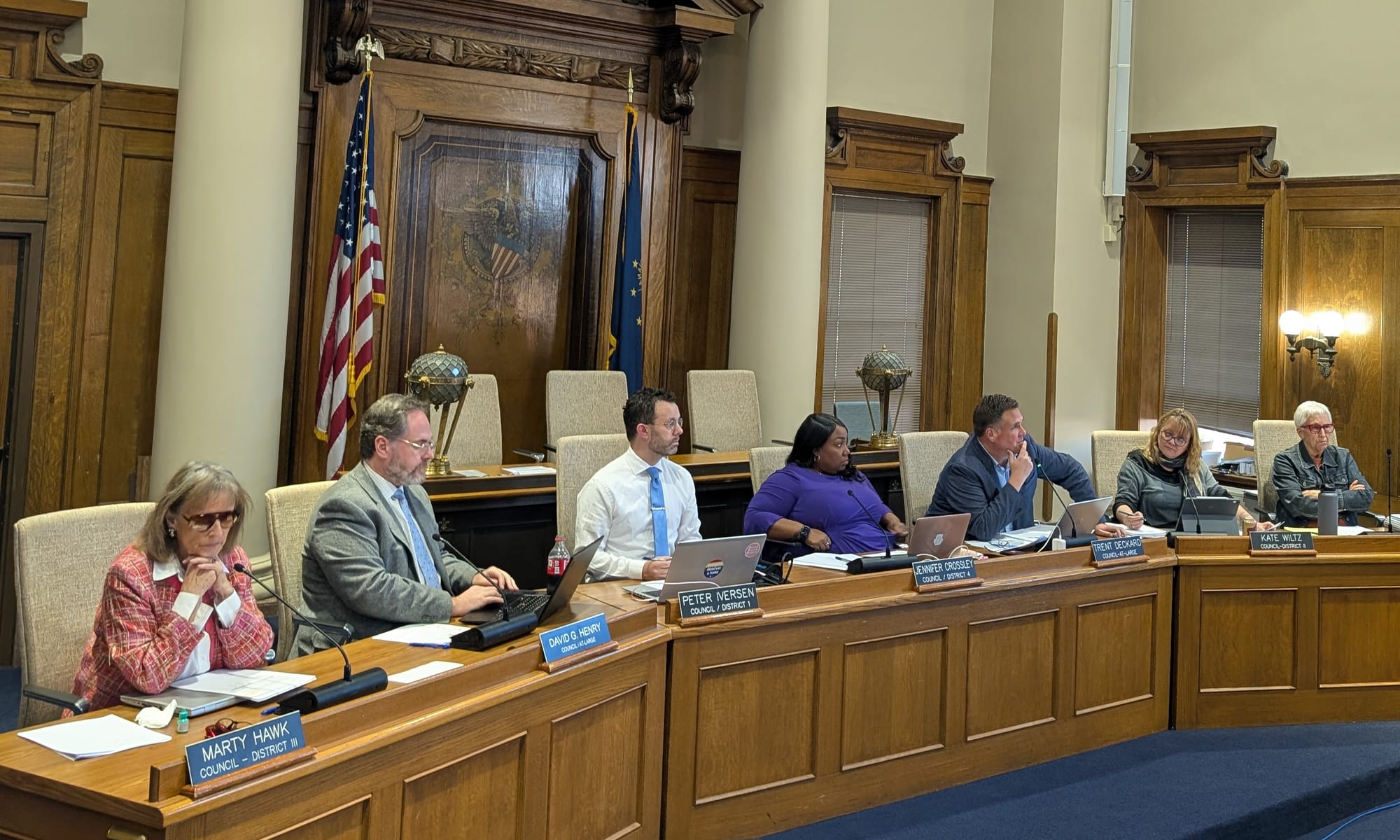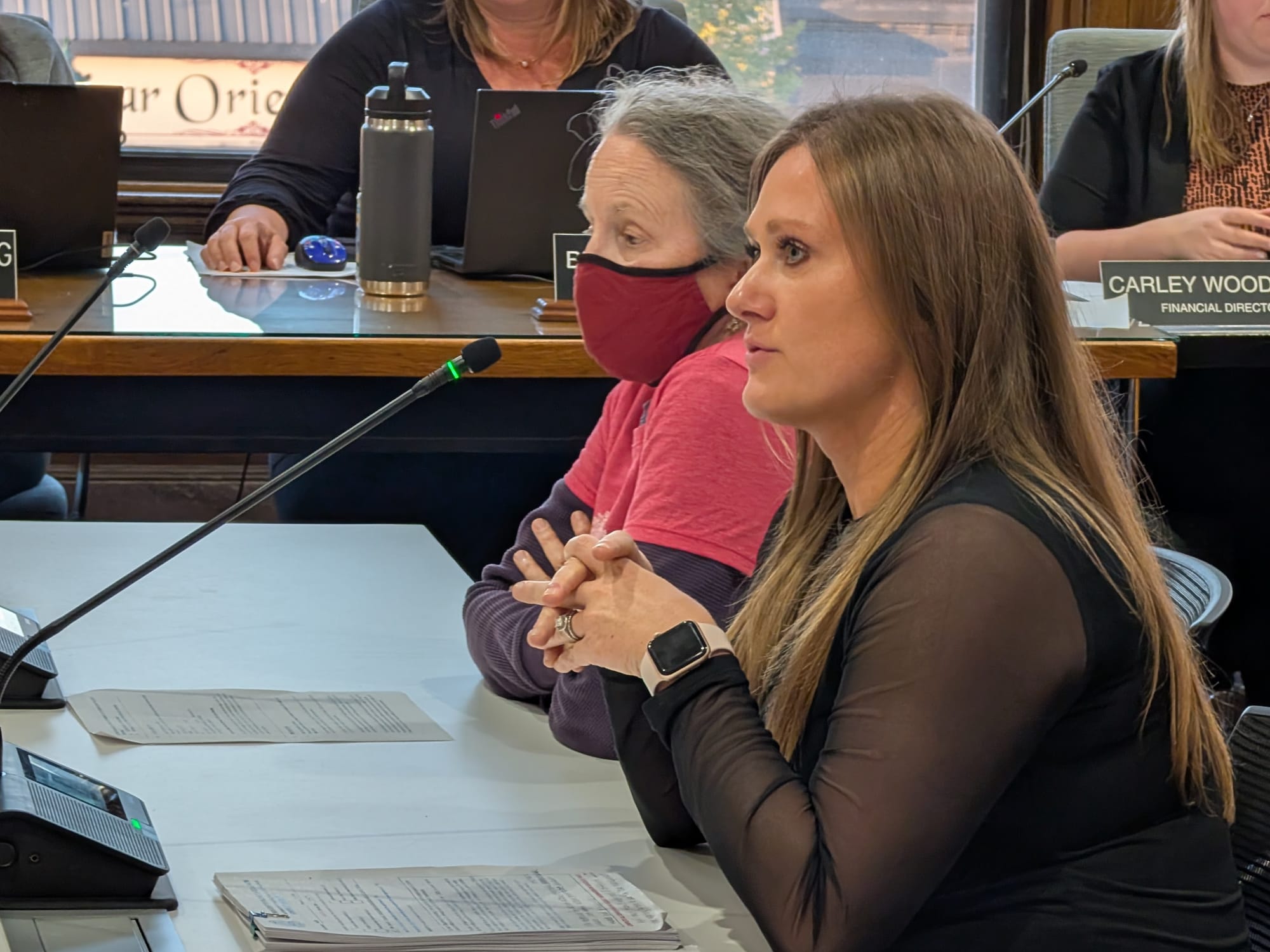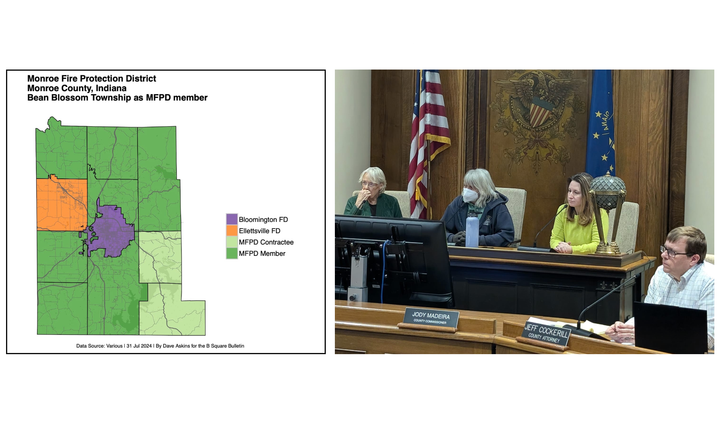Monroe County adopts $131M budget—big decisions still ahead on public health, $6M in bonds
The 2026 budget for Monroe County government, with about $113 million in approved spending, was adopted on Tuesday night by the county council. But the council put off votes on new health department positions and the issuance of $6 million in GO bonds.



Left: Monroe County council from left: Marty Hawk, David Henry, Peter Iversen, Jennifer Crossley, Trent Deckard, Kate Wiltz, and Liz Feitl. Right: From left Monroe County health officer Sarah Ryterband, and Monroe County health administrator Lori Kelley. (Dave Askins, Oct. 15, 2025)
The 2026 budget for Monroe County government, with about $131 million in approved spending, was adopted on Tuesday night by the county council.
The approved budget has a surplus in the general fund of almost $1 million and an overall surplus of about $400,000.
Along with that basic budget, the council approved spending for the Monroe County Waste Reduction District ($3.56 million) and the Monroe Fire Protection District ($20.8 million).
In addition to the budgets, the council approved the salary and wage grids for county employees, which reflected a 3% cost-of-living adjustment (COLA). Elected officials received the same 3% COLA.
But the council also put off decisions about some other big items on the agenda, until its meeting on Oct. 28. The council postponed a decision about the purchase of a vehicle for the health department to provide mobile health services. Also postponed until Oct. 28 was a request to approve some personnel-related steps for three nursing positions, so that hires could be made to replace the public health services that IU Health will stop providing under contract at the end of this year.
The council also delayed a vote until Oct. 28 about the issuance of a $6 million general obligation bond, after voting to remove the Monroe County Nature Preserve projects, which would reduce the planned expenditures by about $1 million.
That means the Oct. 28 agenda will be packed with weighty issues, which are expected to include a requested appropriation to close the real estate deal on North Park, which is the planned location of the county’s new jail and justice complex.
2026 budget
The county county council started its budget season with about an $8 million shortfall in revenues to cover planned expenses.
Getting to a point of showing a planned surplus was achieved through several cuts, which at one point included the elimination of longevity pay, but the council reversed that decision.
In the course of their work on the budget, the county council enacted a new policy regulating overtime, and a hiring freeze.
A big part of the shortfall was made up by moving expenses out of the general fund and into previously untapped sources of revenue—namely, the economic development local income tax revenue (ED LIT) fund and the jail local income tax (LIT) fund. In the few years since that revenue has been available, the county council has treated it as hands-off for regular budgeting, because that money is supposed to be put towards a planned new jail and justice facility building with a working budget of about $225 million.
On Tuesday, councilor Peter Iversen said, “I am going to be supporting this budget because it benefits residents of Monroe County and our over 750 county employees.” Iversen also responded to criticism from employees and the community: “While some have described this year’s process as lacking control, I respectfully disagree. What we’ve seen here is not incompetence, but humility, collaboration, honest acknowledgement of our failures and strident efforts to adapt.”
Councilor David Henry highlighted the fact that unlike some other counties in Indiana, Monroe County is not laying off employees—commonly called “riffing” for the acronym RIF (reduction in force). Henry put it like this: “So I think that’s important to say ... in a time of downturn, our workforce still has jobs on January 1. We are not riffing people, as we’ve seen in other county governments.” Henry also warned that next year, the impact of SEA 1—the legislation that impacted revenues to local governments across the state—would be worse next year.
The budget passed over dissent from councilor Marty Hawk, who noted that the balanced budget was achieved not by reducing expenses in the general fund, but rather by tapping money from local income tax revenues. “So we’re really spending, spending … I’m not finding fault with anyone. …” She added, “We’re all going to have to try to get this under control next year. ”
Councilor Trent Deckard called the process the most difficult he’s seen since he started his council service: “This budget has been the hardest thing that I have ever watched in my time on the council.” Like Henry, Deckard counted it as a positive point that county government employees were not laid off in order to balance the budget: “We have not gone the way of cutting people—not yet.”
Council president Jennifer Crossley looked ahead to the next few years as SEA 1 starts to take full effect and the local income tax system completely changes: “This is the groundwork for what we need to do for the next couple of years.” Crossley said that this year, the council has had hard conversations and pushed back on requests from departments, but in the next few years, the council might need to push back even more.
Health department requests: Vehicle
On Tuesday night, the council also grappled with two major health department initiatives: the proposed purchase of a mobile health services vehicle and the creation of new public health nursing positions, prompted by the end of a longstanding contract with IU Health.
Monroe County health administrator Lori Kelley presented the request to the council saying the money ($500,000) had come from COVID vaccine administration funds. The idea is to purchase a vehicle to provide health services in the community. “We could potentially also use it to purchase a vehicle that could be used by public health nurses for services out in the community as well,” Kelley said.
Councilors raised various concerns. Marty Hawk wanted to see something like a business plan. David Henry addressed the source of the funding raising the possibility that the money could be used more flexibly in other areas of county government, not just the health department: “I just want to make sure that if we have an opportunity to put money back in county coffers first, before we commit to new programs, that’s what we’re doing.”
Councilors voted to postpone the item until their Oct. 28 meeting, so that they could get more information on long-term costs and guidance from the state government about the use of the funding.
Health department requests: Nursing positions
The challenge confronting the health department is the replacement of public health nursing services previously provided under a long-standing contract with IU Health—a contract that is ending after more than 60 years. The health department is now required either to provide these services in-house or find another provider by Jan. 1, 2026, to comply with state law.
Health administrator Lori Kelley’s preferred option is to provide the mandated public health services in-house, operating out of the health building at 7th Street and College Avenue. At Tuesday’s county council meeting, Kelley focused on the urgency of the issue, given that the county has to make sure it is providing all of the legally mandated services and services, starting Jan. 1.
The department’s request was to create one new nursing position and revise three existing job descriptions, in order to staff up for the transition. But councilors were divided on the best approach.
Marty Hawk and David Henry were skeptical of moving directly to in-house hires, suggesting that contracting out the services might be more efficient and less risky. Hawk said, “It seems to me the choice is, we either provide positions … or we find somebody that we can contract with.” Hawk added, “And then if something goes wrong, it’s their problem, rather than us trying to reinvent the wheel here to make this work.”
Henry pressed for a more thorough exploration of alternatives, asking for a “market survey” of potential providers and questioning whether the county had fully investigated contracting with other entities. He also raised concerns about the timeline for a hiring process, saying that it’s already mid-October and the county has had a hard time filling other positions in the department.
Peter Iversen acknowledged the time crunch and the difficulty of hiring public health professionals, especially if the county’s job classifications and pay rates are not competitive. He argued for a dual-track approach: “There’s a very real possibility, I think, that even if we approve this tonight, we still won’t have it in place in time.” Iversen added, “There is a world where we approve this, and we’ll need some sort of contract in place to get us through a couple months before people can be hired...”
Trent Deckard echoed the need for flexibility and for the idea of a “both and” approach. The council wound up postponing the agenda item until Oct. 28, but passed a motion that directed the legal staff not to send proposed job descriptions to the county’s outside human resources consultant for review, at least not yet.
In addition, the council’s legal counsel is supposed to research how other counties, like Johnson County, provide public health nursing services. Finally, the council’s motion asked the health department to solicit quotes from vendors to contract for nursing services, with the goal of having options ready for council consideration at the Oct. 28 meeting.
$6 million general obligation (GO) bond
Councilors zeroed in on two major line items: the Monroe County Nature Preserve and the Justice Center building.
David Henry was critical of Monroe County’s long-term approach to issuing and managing bonds. Henry noted that some bonds issued over a decade ago still have residual funds sitting unused, and in that context questioned why the county continues to add new multi-million dollar bonds to the books each year. “We’ve been talking past each other about the current bonds that are being held by the commissioners over an 11-year period that add up to about $5.9 million in stuff—and then to add a $6 million in addition to that dollar amount... we could be revisiting $6 million bonds every year,” Henry said.
Henry called for the council to “bake-in requirements on the commissioners to provide project plans, including a 30-60-90-day spend down,” and suggested that if such requirements could not be included in the bond ordinance itself, the council should consider a separate resolution to ensure regular reporting and tighter controls.
Henry pointed to the ongoing work to relocate early voting and voter registration services to the North Showers building. He pressed for a clear project timeline and contingency plans, noting the critical importance of having the work completed before the 2026 primary season.
The Monroe County Nature Preserve, initially slated for $775,000 in improvements, along with a $130,000 allocation for a dog park, became a focal point for debate. Councilor David Henry moved to strike both from the bond issuance documents, saying that the food and beverage tax revenues might be a more appropriate source of funding for that project. The vote to strike the nature preserve items from the bond issuance description was approved unanimously.
From the remote public mic, Eric Spoonmore, CEO of the Greater Bloomington Chamber of Commerce and a former county councilor, supported the council’s move to strike the nature preserve items: “Nature preserve, nix it. Dog park, nix it. We have real human beings that are suffering in the jail, in the justice building... Human beings and our people there need this help, and let’s make sure that we get that repaired. We don’t need to worry about dog parks. The nature preserve can wait.”
The justice center building’s inclusion in the bond package was itself a matter of confusion. Councilors referred to an exhibit list from commissioners administrator Angie Purdie dated October 10, which listed $270,000 for justice building repairs. But the phrase “justice building repairs” did not appear in the documents that the council was asked to approve. The council voted to add the wording to the project list to be approved with their vote.
The council wound up putting off a vote on the $6-million bond issuance until its Oct. 28 meeting to ensure that critical needs—especially those related to public safety and facility maintenance—are fully addressed.




Comments ()